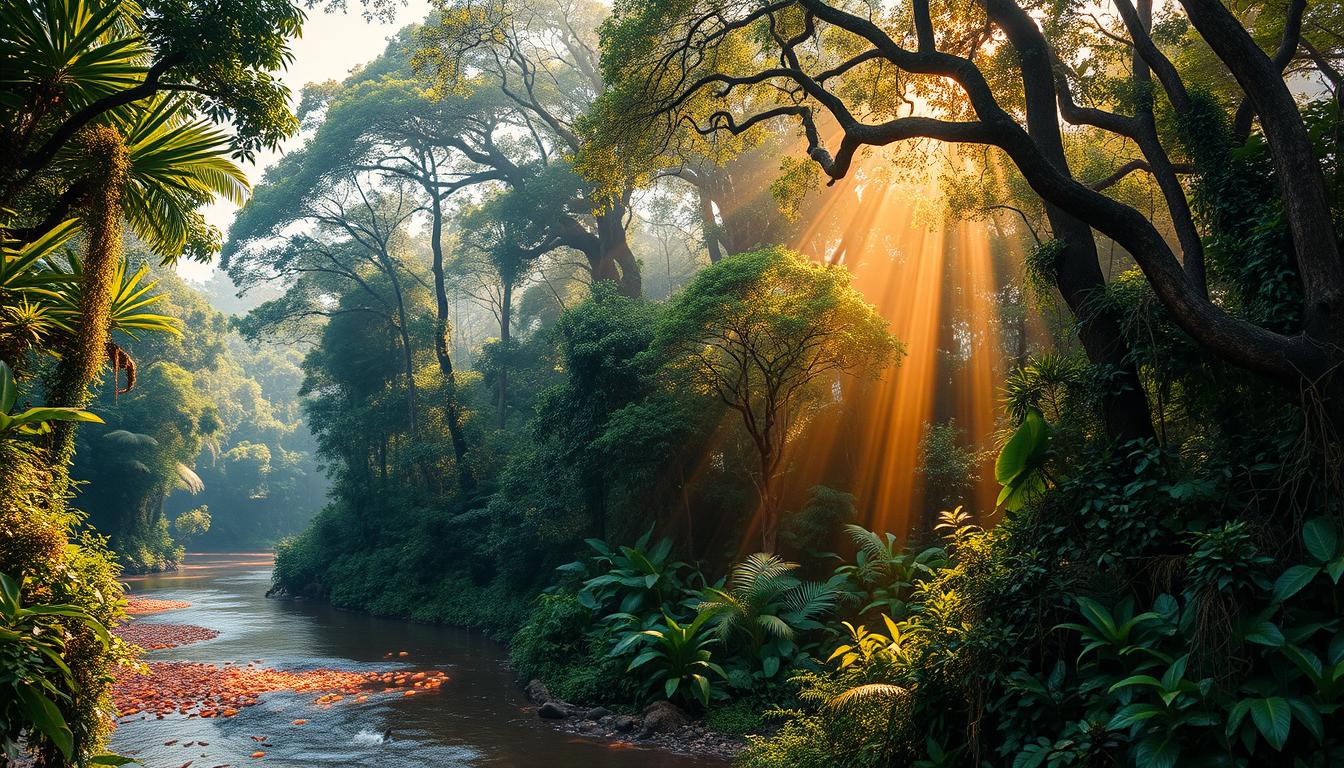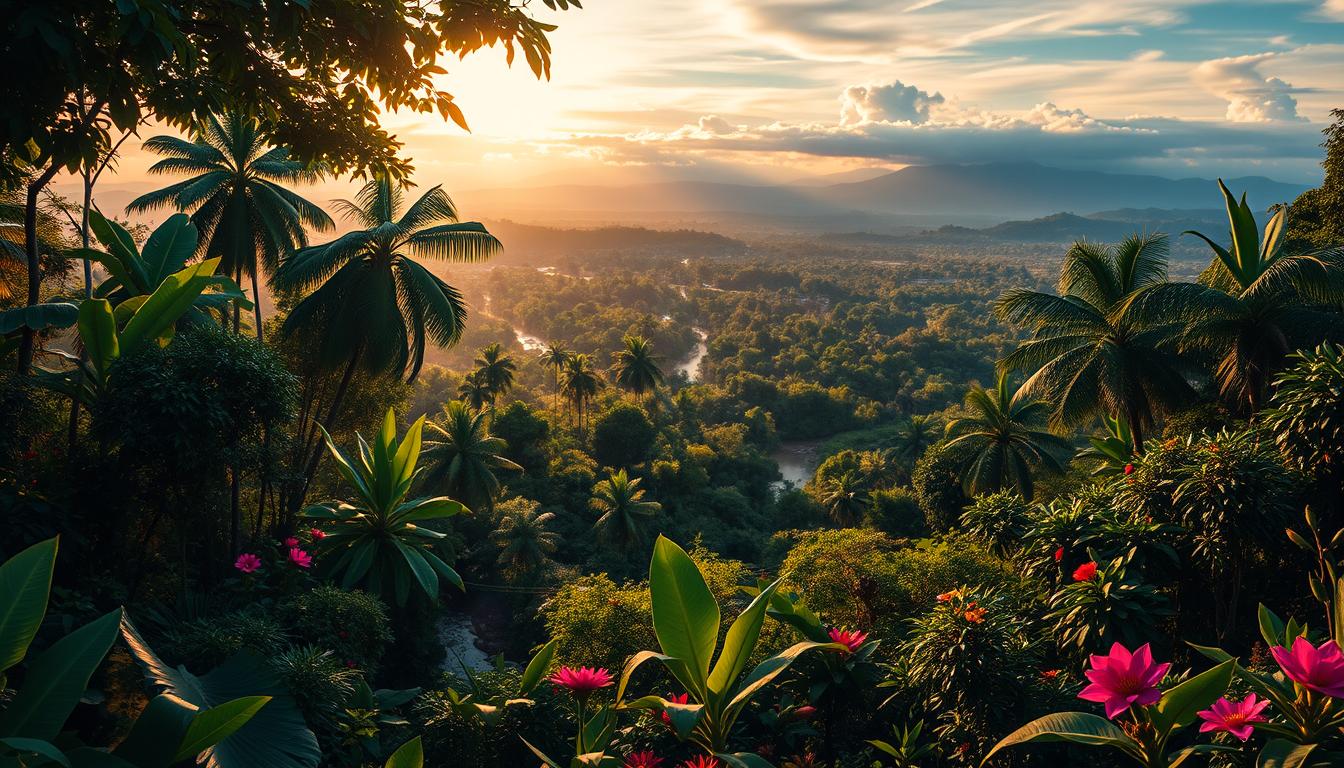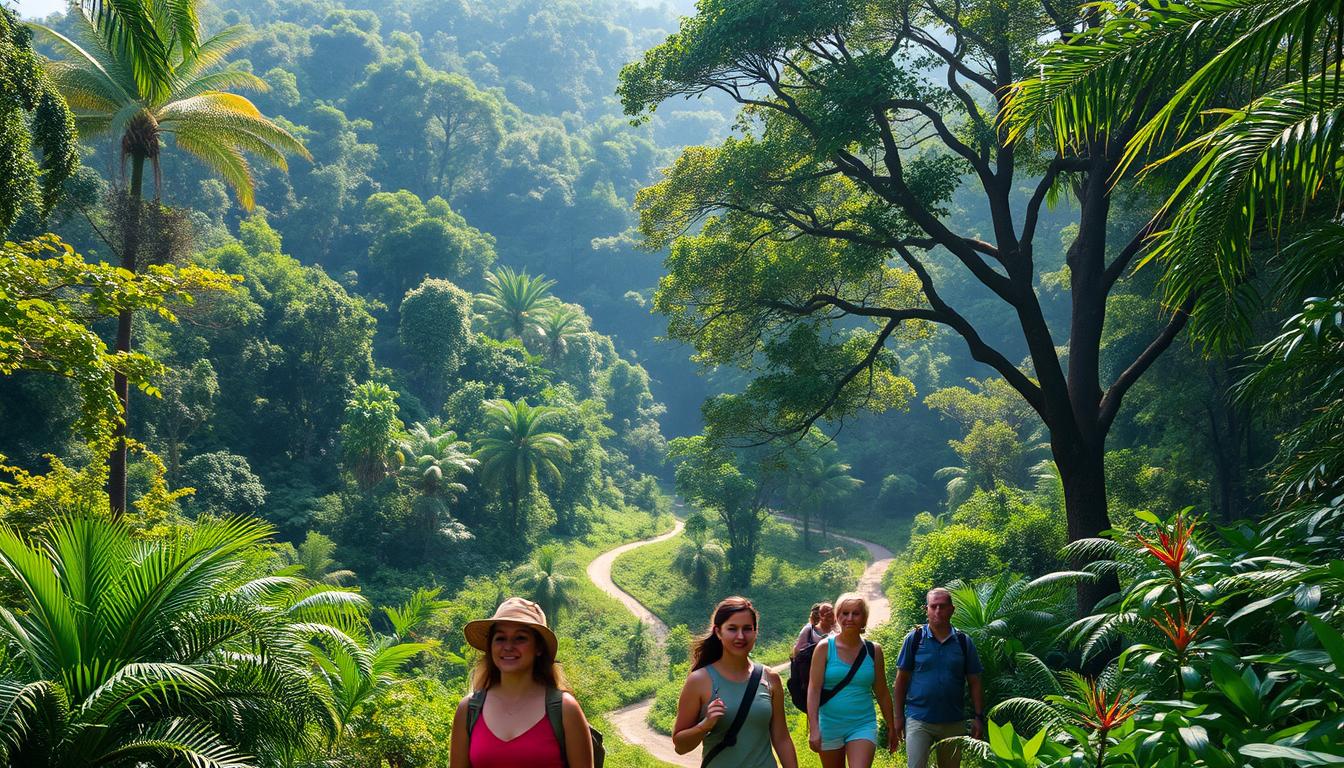The Amazon River basin is home to 10% of the world’s known biodiversity, making it one of the most biologically diverse regions on the planet. Spanning across South America, this vast rainforest is a marvel of nature, attracting adventurers and nature lovers alike.
The largest rainforest in the world, the Amazon, is a biodiversity hotspot, teeming with life and full of surprises. With its vast array of flora and fauna, it plays a crucial role in maintaining the health of our planet.
Key Takeaways
- The Amazon River basin is a significant biodiversity hotspot.
- It spans across multiple countries in South America.
- The region is home to a vast array of flora and fauna.
- The Amazon rainforest plays a crucial role in global ecological health.
- It is a popular destination for nature lovers and adventurers.
The Mighty Amazon: Facts and Figures
Spanning thousands of miles, the Amazon River is not just a river, but a vital ecosystem that supports an array of life. Its grandeur is reflected in the impressive facts and figures that surround it.
Origin and Course of the River
The Amazon River originates in the Peruvian Andes, a region known for its rugged terrain and rich biodiversity. From there, it begins its journey through the Amazon Basin.
The Peruvian Andes Beginnings
The river’s source is located in the snow-capped peaks of the Andes, where the Apurímac River is considered the most distant source of the Amazon River.
Journey Through Nine Countries
As the Amazon River flows east, it traverses through nine countries, including Brazil, Peru, and Colombia, supporting a vast array of cultures and ecosystems.

Size and Scale Comparison
The Amazon River is renowned for its massive scale, setting records in both volume and length.
Volume and Length Records
It is the largest river in the world by discharge volume, accounting for about 15% of the fresh water that flows into the oceans. The river’s length is approximately 4,000 miles, making it one of the longest rivers globally.
| Category | Amazon River | Comparison |
|---|---|---|
| Discharge Volume | 209,000 m³/s | Largest in the world |
| Length | Approximately 4,000 miles | One of the longest |
Climate and Seasonal Changes
The Amazon River’s climate is characterized by significant seasonal changes, affecting both the river and the surrounding rainforest.
Wet and Dry Seasons Impact
The wet season brings heavy rainfall, causing the river to swell and expand its banks, while the dry season sees a decrease in water levels, exposing riverbeds and sandbars.
“The Amazon River is a dynamic ecosystem that is intricately linked with the climate and seasonal changes, supporting an incredible array of life.”
Whether you’re planning a jungle adventure or a relaxing river cruise, understanding the Amazon River’s facts and figures enhances the appreciation of this natural wonder.
The Amazon River: A Journey Through the World’s Largest Rainforest
The Amazon River and its surrounding rainforest form a complex, interconnected system that is vital to the health of our planet. This ecosystem is characterized by its incredible biodiversity and plays a crucial role in regulating the Earth’s climate. As we journey through this region, we gain a deeper appreciation for the intricate balance between the river and the rainforest.
The Amazon Basin Ecosystem
The Amazon Basin is home to a variety of ecosystems, including floodplains and Várzea forests, which are crucial for the region’s ecological health. These areas are periodically flooded, creating a unique environment that supports a wide range of plant and animal life. The dynamic nature of these ecosystems makes them fascinating subjects for study and exploration.
Floodplains and Várzea Forests
Floodplains and Várzea forests are integral components of the Amazon Basin ecosystem. They provide habitat for numerous species and play a key role in nutrient cycling and seed dispersal. The periodic flooding of these areas brings nutrient-rich sediments that support the growth of lush vegetation.

Interconnection Between River and Rainforest
The Amazon River and the surrounding rainforest are intricately connected, with each component supporting the other. The river provides sustenance for the forest, while the forest helps maintain the river’s health through processes like nutrient cycling and seed dispersal. This interconnection is vital for maintaining the balance of the ecosystem.
Nutrient Cycling and Seed Dispersal
Nutrient cycling and seed dispersal are critical processes that occur within the Amazon ecosystem. The river’s annual flooding brings nutrients that support the growth of vegetation, while the forest’s diverse plant life ensures the dispersal of seeds across the region. This process is essential for maintaining the forest’s biodiversity and ecological health.
Ecological Importance to the Planet
The Amazon rainforest is often referred to as the “Lungs of the Earth” due to its significant role in producing oxygen. The region’s ecological importance extends beyond its local environment, influencing global climate patterns and supporting biodiversity on a planetary scale. Understanding and preserving this ecosystem is crucial for the health of our planet.
The “Lungs of the Earth” Explained
| Ecological Role | Description | Importance |
|---|---|---|
| Oxygen Production | The Amazon rainforest produces a significant portion of the world’s oxygen through photosynthesis. | Crucial for supporting life on Earth |
| Carbon Sequestration | The forest acts as a carbon sink, absorbing CO2 from the atmosphere. | Helps mitigate climate change |
| Biodiversity Support | The Amazon is home to a vast array of plant and animal species. | Essential for maintaining ecological balance |
By understanding the ecological importance of the Amazon rainforest, we can better appreciate the need for conservation efforts. Protecting this region is not just a local issue but a global imperative.
Extraordinary Biodiversity of the Amazon
With its vast and varied ecosystems, the Amazon stands as one of the most biodiverse regions on the planet. This biodiversity is not limited to its rainforests but extends into its rivers and streams, creating a complex web of life.
Aquatic Life in the River
The Amazon River is home to an incredible array of aquatic life. From the majestic pink river dolphins to the playful giant otters, the river supports a diverse community of species.
Pink River Dolphins and Giant Otters
The pink river dolphin is not only a rare sight but also a symbol of the Amazon’s mystique. Meanwhile, giant otters are often seen as indicators of the river’s health due to their sensitivity to environmental changes.
Piranhas and Electric Eels: Myths vs. Reality
Piranhas and electric eels are among the Amazon’s most fascinating and feared creatures. While piranhas are often portrayed as vicious predators, they play a crucial role in the ecosystem. Electric eels, with their ability to generate electricity, are a marvel of nature.
Rainforest Flora: A Pharmacy of Nature
The Amazon rainforest is often referred to as a “pharmacy of nature” due to its vast array of medicinal plants. These plants have been used for centuries by indigenous communities to treat various ailments.
Medicinal Plants and Their Uses
From treating fever to curing snake bites, the Amazon’s medicinal plants offer a wealth of remedies. The cat’s claw vine, for example, is known for its anti-inflammatory properties.
Iconic Amazon Wildlife
The Amazon is home to some of the world’s most iconic wildlife, including jaguars and poison dart frogs. These species are not only a testament to the Amazon’s biodiversity but also play crucial roles in their ecosystems.
From Jaguars to Poison Dart Frogs
Jaguars are the largest cats in the Americas, and their presence is a sign of a healthy ecosystem. Poison dart frogs, with their vibrant colors, are a highlight of the rainforest, and their toxicity has inspired medical research.
Indigenous Cultures Along the Amazon
For millennia, the Amazon Basin has supported a diverse array of indigenous tribes, whose lives are intricately linked to the river. The Amazon River and its surrounding rainforest have been the cornerstone of their existence, providing sustenance, shelter, and spiritual nourishment.
Ancient Civilizations and Their Legacy
The Amazon has been home to ancient civilizations that have left behind a rich cultural heritage. Archaeological findings have revealed sophisticated farming practices and complex societal structures.
Archaeological Discoveries and Terra Preta
One of the most significant archaeological discoveries in the Amazon is Terra Preta, or “black earth,” which indicates the presence of ancient, highly fertile soil created by indigenous peoples. This finding highlights their advanced understanding of agriculture and soil management.
Contemporary Tribes and Their Way of Life
Today, numerous indigenous tribes continue to thrive in the Amazon, relying on traditional knowledge passed down through generations to adapt to their environment. Their way of life is a testament to the resilience and resourcefulness of indigenous cultures.
Traditional Knowledge and Adaptation
Indigenous communities have developed unique strategies to survive in the Amazon’s challenging environment. Their knowledge of the rainforest’s medicinal plants, hunting practices, and social structures is invaluable.
Cultural Significance of the River
The Amazon River holds profound cultural significance for indigenous communities. It is not just a source of water but a sacred entity that features prominently in their myths, legends, and spiritual practices.
Myths, Legends, and Spiritual Connections
As one indigenous leader once said,
“The river is our lifeblood, our history, and our future. It connects us to our ancestors and to the natural world.”
This quote encapsulates the deep spiritual connection between the indigenous peoples and the Amazon River.
The cultural heritage of the Amazon’s indigenous tribes is a treasure that enriches our understanding of human diversity and our relationship with the natural world. As we move forward, it is crucial to respect and preserve this cultural significance for future generations.
Exploring the Amazon: Tourism and Adventures
Exploring the Amazon is an unforgettable experience, with opportunities for river cruises, jungle expeditions, and more. The Amazon River and its surrounding rainforest offer a diverse range of tourism and adventure activities that cater to different interests and preferences.
River Cruises and Boat Tours
One of the most popular ways to experience the Amazon is through a river cruise. These cruises offer a relaxing way to see the vast array of wildlife and ecosystems that the Amazon is known for.
From Luxury to Authentic Experiences
From luxurious river cruises to more authentic, local boat tours, there’s something for everyone. Luxury cruises provide high-end amenities and guided tours, while authentic boat tours offer a more immersive experience into local culture and daily life.
Jungle Expeditions and Eco-Lodges
For those looking for a more adventurous experience, jungle expeditions are a great option. These expeditions often include stays at eco-lodges, which provide a unique opportunity to stay within the rainforest.
Wildlife Spotting and Canopy Walks
During these expeditions, visitors can enjoy wildlife spotting and canopy walks, getting up close and personal with the Amazon’s incredible biodiversity. Canopy walks allow visitors to explore the rainforest from a new perspective, high above the forest floor.
Responsible Tourism Practices
As tourism in the Amazon continues to grow, it’s crucial to prioritize responsible tourism practices. This includes supporting local communities and conservation efforts.
Supporting Local Communities
By choosing to stay at locally owned eco-lodges and participate in tours operated by local guides, visitors can directly support the local economy. This not only benefits the local communities but also enhances the overall tourism experience.
| Tourism Activity | Description | Benefits |
|---|---|---|
| River Cruises | Relaxing way to see Amazon wildlife and ecosystems | Supports local economy, offers guided tours |
| Jungle Expeditions | Adventure experience including eco-lodges | Immersive experience, supports conservation |
| Eco-Tourism | Focuses on responsible travel to natural areas | Conserves environment, supports local communities |
Preserving the Amazon for Future Generations
The Amazon rainforest is a vital component of our planet’s biodiversity, and its conservation is crucial to maintaining the delicate balance of nature. As we conclude our journey through the Amazon River, it’s clear that this incredible ecosystem is worth preserving.
By supporting eco-tourism and responsible tourism practices, we can help protect the Amazon and its inhabitants. Eco-tourism initiatives promote rainforest conservation by providing economic benefits to local communities and raising awareness about the importance of preserving the Amazon rainforest.
It’s our responsibility to ensure that this incredible ecosystem continues to thrive. By working together, we can make a positive impact on the Amazon and the world at large. The Amazon’s biodiversity is a treasure that requires our care and protection.




